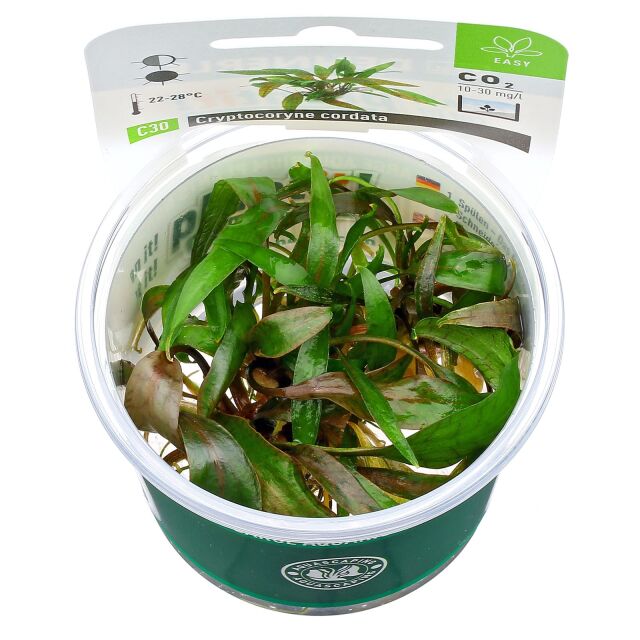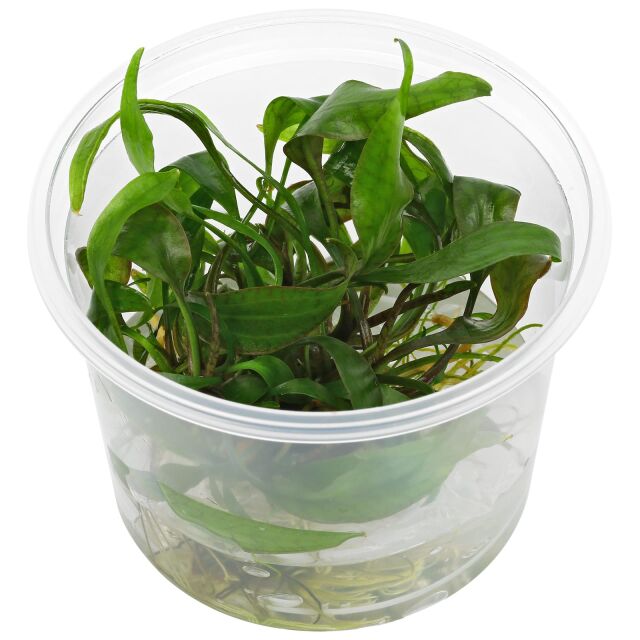Siamese water trumpet



Cryptocoryne cordata var. siamensis
Siamese water trumpet
- Lanceolate leaf shape
- Olive green with darker veins
- Suitable for the midground
- Low lighting demand
- Slow growth rate
Sign in or Register
Item question
We’re here for you!
Please enter your question and e-mail and we’ll contact you as soon as possible. It usually takes us up to 24 hours during business days to respond.
Thank you for your question!
Thank you, we’ll get in touch!
Close window
You already sent us a question.
Please wait a few minutes
Description
The Siamese water trumpet is a variety of Cryptocoryne cordata from the south of Thailand. There it occurs in calcareous, shaded flowing waters, in contrast to the type variety Cryptocoryne cordata var. cordata, which occurs in acidic, soft waters on the Malay Peninsula. The variety siamensis is very variable in size, leaf shape and colouration, and in aquarium culture there are different forms. For example, the large, broad-leaved "Cryptocoryne blassii" was popular decades ago as an undemanding aquarium plant, but has become rare in the hobby today.
The form we offer (Dennerle abbreviation C30) is smaller and narrower-leaved than the form "blassii". It has lanceolate, somewhat shiny leaves with an attractive dark line pattern and reddish-purple underside. Especially under intense light, the plant hardly grows taller than 10 cm for a long time, with a spreading habit. After a long time, especially in low light and with plenty of nutrients, it can grow over 20 cm tall. The petioles are then often longer than the leaf blades, which are about 7 - 8 cm long. Through underground runners, Cryptocoryne cordata var. siamensis can form a lush, dense stand over time.
In shallow water or in emersed culture, inflorescences with a long tube and yellow spathe blade may appear.
This slow-growing Cryptocoryne can be kept in soft to hard water. The Siamese water trumpet is particularly suitable for aquariums with fish and without added CO2, which are only dimly to moderately lit. However, it also thrives in intensive light and with added CO2. Nutrient supply via the substrate is very beneficial for its growth. The optimum temperature range for this tropical aquatic plant is between about 22 and 28 °C. Propagation is done by cutting off young plants that develop on the underground runners.
This relatively small form of Cryptocoryne cordata var. siamensis makes an interesting accent as a younger plant in the foreground to midground with its spreading, dark marbled leaves. Older, taller stands fit better in the middle to background. The Siamese water trumpet is versatile and also a suitable plant for tropical river biotope aquariums. In open, shallow tanks, you can count on its attractive inflorescences with yellow spatha.
Cryptocoryne cordata var. blassii originates from swamplands in southern Thailand, Malaysia and on the island of Borneo. It is the most popular variety of C. cordata and very easy in cultivation.
This Cryptocoryne is an undemanding slow grower. It needs low to medium light (0.25-0.5 watts per litre), as its natural habitat is in shaded rivers. It does not require additional CO2, however, CO2 fertilisation may have a positive effect on growth. It can be kept in hard water very well. In order to reach its full height it needs a substrate rich in nutrients.
The emersed cultivation of C. cordata var. blassii is easy. It only needs low light and should be sprayed with water from time to time in order to increase the humidity. It also needs a nutrient-rich substrate when cultivated above the waterline. (read more)
| Synonyms | Cryptocoryne blassii de Wit, Cryptocoryne evae var. evae Rataj, Cryptocoryne evae var. recordata Rataj, Cryptocoryne siamensis Gagnep., Cryptocoryne siamensis Gagnep. var. ewansii Rataj |
| Misapplied names | Cryptocoryne × purpurea |
| Trader names | Cryptocoryne cordata var. blassii |
| Complete botanical name | Cryptocóryne cordáta Griffith var. siaménsis (Gagnepain) N. Jacobsen & D. Sookchaloem |
| Family | Araceae |
| Genus | Cryptocoryne |
| Difficulty | easy |
| Usage | Background, Midground, Specimen plant |
| Growth | slow |
| pH value | 4 - 7 |
| Temperature tolerance | 17 - 30°C |
| Carbonate hardness | 2 - 12°dKH |
| General hardness | 0 - 30°dGH |
| Propagation | Runners, Rhizomteilung, Splitting, cutting off daughter plants |
| Can grow emersed? | yes |
| Source | Flowgrow |
| Synonyms |
| Cryptocoryne blassii de Wit, Cryptocoryne evae var. evae Rataj, Cryptocoryne evae var. recordata Rataj, Cryptocoryne siamensis Gagnep., Cryptocoryne siamensis Gagnep. var. ewansii Rataj |
| Misapplied names |
| Cryptocoryne × purpurea |
| Trader names |
| Cryptocoryne cordata var. blassii |
| Complete botanical name |
| Cryptocóryne cordáta Griffith var. siaménsis (Gagnepain) N. Jacobsen & D. Sookchaloem |
| Family |
| Araceae |
| Genus |
| Cryptocoryne |
| Difficulty |
| easy |
| Usage |
| Background, Midground, Specimen plant |
| Growth |
| slow |
| pH value |
| 4 - 7 |
| Temperature tolerance |
| 17 - 30°C |
| Carbonate hardness |
| 2 - 12°dKH |
| General hardness |
| 0 - 30°dGH |
| Propagation |
| Runners, Rhizomteilung, Splitting, cutting off daughter plants |
| Can grow emersed? |
| yes |
| Source |
| Flowgrow |
General information
Please choose a variant to see more information.
| Item no. |
|
| EAN | |
| Weight | |
| Shipping weight |
Customers ask customers
You have questions about this product? Ask other customer or our support team about this product!
Customer reviews
2 Reviews
| 5 Stars(2) |
|
| 4 Stars(0) |
|
| 3 Stars(0) |
|
| 2 Stars(0) |
|
| 1 Star(0) |
|

This arrived quickly and the plants were in good condition. You get a number of plantlets in the invitro pot and I am excited to see how they will develop!